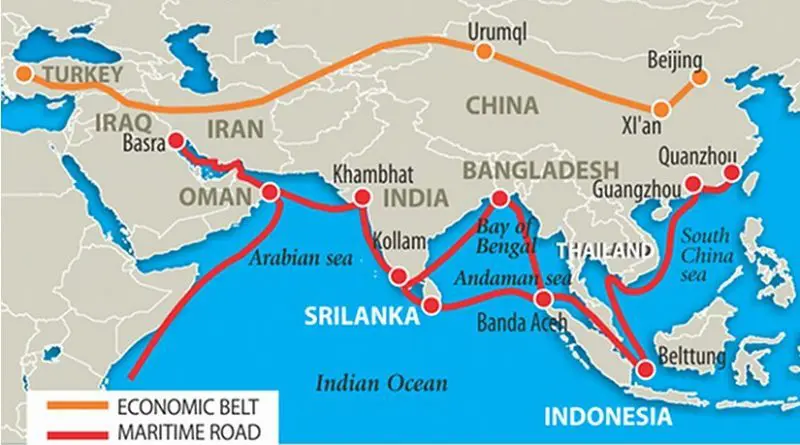Can India Complement And Gain From China’s Belt And Road Initiative? – Analysis
By IPCS
By Sreejith Nair*
China will eventually embark on its vision of building roads, railways and pipelines across Eurasia, irrespective of India’s endorsement of the Belt and Road Initiative (BRI). This attempt to lay foundations of a Sino-centric Asia provides India opportunities and challenges alike. An obstructionist approach does not favour India’s interests. It would be more advantageous to complement BRI, providing key low cost links in the greater Chinese jigsaw to optimise competition for strategic space.
Where can India complement Chinese efforts in a way that benefits its own economic and strategic interests? The Central Asia-West Asia corridor is a branch of the BRI where India can reap significant gains. The corridor runs horizontally (east-west) across Asia from western China to Turkey. The connectivity project, North-South Transport Corridor (NSTC), which India is a part of, is a perfect economic complement to the BRI, because it runs vertically across Asia: from Mumbai to Moscow via Iran. Once interconnected, the two initiatives can boost intra-regional connectivity leading to a unified energy market in Asia, allowing for energy price rationalisation. Asia’s natural gas prices are currently the highest globally, almost twice the market price in Europe, and three times the market price in the US (World Energy Council Report, 2016). Greater regional connectivity pushes the bargaining power more in the buyer’s favour – enabling lower prices – which are certainly in India’s economic interests.
Moreover, India does not have to be a member of BRI to benefit from it. China has already signed transportation, customs cooperation, and quality assurance agreements with several BRI member countries. For India to be able to tap into the opportunities created by linking NSTC to BRI, it is important to pursue Free Trade Agreements (FTA) under an India-Central Asia FTA framework and an India-Eastern European Union FTA. These FTAs not only remove tariff barriers but also ensure competitiveness of Indian goods. The recent accession of India to the United Nations Transports Internationaux Routiers (TIR) convention is a promising step in this direction. The TIR convention, which all Central Asian countries are signatories to, allows Indian traders to have access to fast, reliable, and hassle-free border transit across 70 countries.
In the long-term, the NSTC-BRI linkage coupled with FTAs have the potential to change Eurasia’s trade and energy dynamics. This can be strengthened further through the integration of the strategic Chabahar port with the NSTC. Such a link up allows India to benefit from Chinese-constructed access to major markets and resource supplies in Central Asia, West Asia, and Europe by investing capital only in the last mile connectivity to Chabahar. Peripheral projects such as upgrading the NSTC’s existing rail and road infrastructure and setting up satellite hubs for trade can act as value additions to complement the BRI architecture as and when required. The BRI-NSTC linkage thus helps Indian economic interests without making India directly dependent on China or requiring India to subsume its political interests within China’s. It is important to point out that linking NSTC to BRI is not equivalent to India joining BRI. Providing external connectivity to the BRI through complementary value additions is different from signing up as its member. A careful distinction such as this allows enough room for diplomatic manoeuvre. India can thus connect to BRI from the outside, while still abstaining from formally endorsing it.
These opportunities do not come without challenges. In evaluating the threats, it is imperative to factor in Chinese military presence in the Indian Ocean. In this context, connectivity between BRI and NSTC and its integration with Chabahar port, increase the stakeholders in trade through the Indian Ocean region. It allows the five Central Asian Republics and Russia the cheapest and the fastest access to the Indian Ocean, opening up new markets in ASEAN and Africa. The more countries depend on Indian Ocean-centric trade, with last mile connectivity provided by India, the less China will succeed in its attempts to militarise the Indian Ocean. This also opens up new balancing opportunities through forums like the Indian Ocean Rim Association (OIRA) on the soft side of the spectrum, graduating all the way up to the India-Australia-Japan-US Quad on the hard power end in the Indo-Pacific.
While economically countering China’s USD 1.3 trillion investments in the region is not feasible, piggybacking on it for economic and political gains, with minimal, carefully planned supplements to it, is not only feasible but also strategically wise. Essentially, this would mean China investing a lion’s share in BRI, and India adding to it marginally from the outside but reaping significant benefits. This ‘complement and compete’ strategy can seamlessly fit within a larger Indian counter strategy towards a China-centric Asia. This approach requires a comprehensive and holistic revaluation of the current strategy by Indian policy-makers.
* Sreejith Nair
Research Intern, IPCS


Sir have you taken in to consideration of China’s dumping policy???? I you want an example just check the Smartphone Market in Bharat.
You say we can not compete with them in road construction or the investment but urges our policy-makers to compete with them on there strong point of all i.e. “Trade”.
The article highlights some obstacles that are both unfortunate and avoidable. We need a new mindset in India to facilitate progress. India should cooperate with China to build a high-speed railway lines between Delhi and Beijing. A northern route should be VIA Nepal. A southern route should be VIA Mandalay, with a spur through Yangon and Dhaka to Kolkata. These routes between the two most heavily populated nations on earth would quickly become the most heavily used rail routes on earth, facilitating travel, trade, tourism and transport, and providing employment for millions. What are you waiting for, India?